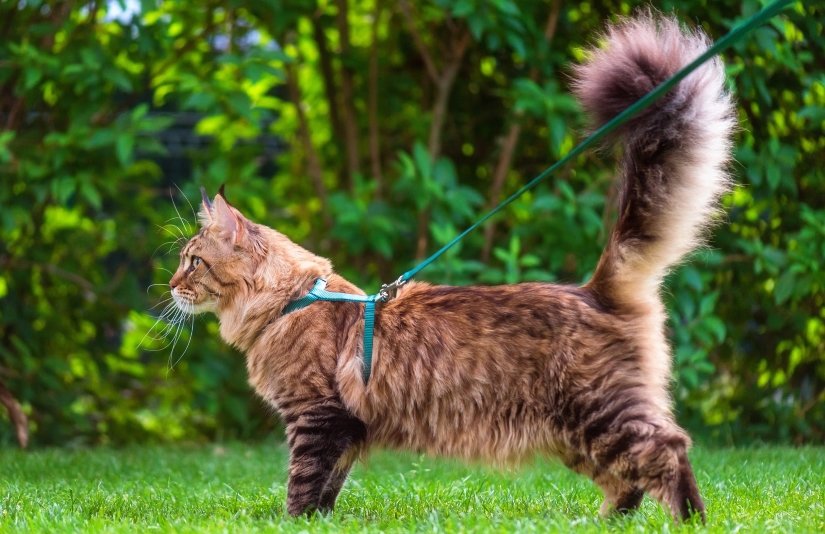How to safely walk your cat on a leash helps you avoid obesity linked to indoor cats, and teaches you how to use the clicker to train your cats. This guide will also show you how to keep your cats safe.
How to Train Your Cat?
We all enjoy being together with our feline friends. Additionally, cats love to roam and will bond with you faster when going for long walks together outdoors. With cats being true carnivores, you’ll need to bring along some high-value treats so that you can spoil your cat, and show your appreciation for walking safely on the leash. Here are some cat walking tips:
- Opt for a lightweight cat harness, collar with tags, and leash.
- Cat collars have to have a good fit and be comfortable and secure.
- Start cat leash training at home with high-quality cat treats to be used as rewards.
- Cat leash training needs to be done in small sessions of 3-5 minutes each, and should always end on a good note.
- Some cat breeds may be easier to walk on a leash than others.
- Socializing your kitten from a young age helps, in that your kitten will get used to new sounds and new environments during kittenhood, making training easier.
- Start off with walking one cat only in a calm environment that is free of distractions.
- Consider clicker training when working with cats.
- Never use a dog harness and dog leash on your cat, since they may be too heavy, and also may slip off due to spec sizes being different for cats and small dog breeds.
- Slender-framed and small cats will need to be fitted specifically with a good sized – cat harness to make sure that they don’t slip out of it and run away.
How to Protect Your Cat When Walking Outside?
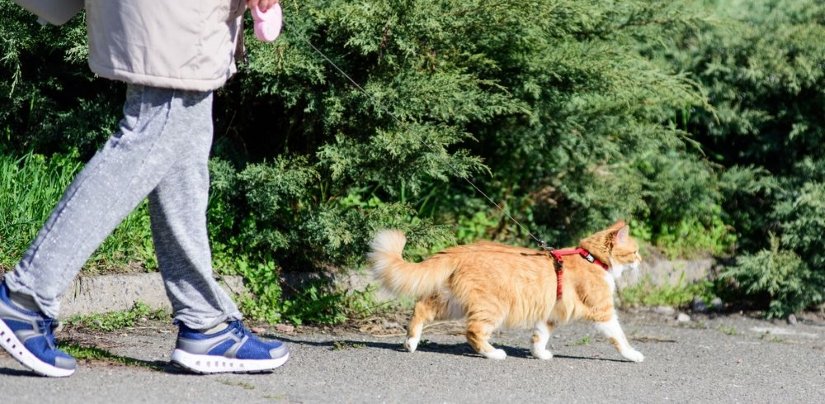
We love our cats, and want the best for them. That said, enjoying the outdoors with your furry best friend allows for him to get the best of both worlds, with lots of mental stimulation, all the while keeping him safe from the dangers and health hazards that outdoor cats face.
Bored cats face feline depression, anxiety and aggression even with the right amount of indoor environmental enrichment. Nothing beats the outdoors, fresh air, birds, and different alluring scents and environmental stimuli.
By training your cat with a clicker through positive training, you’ll find that he or she will be more responsive to you. Here are some positive clicker training tips for training your cat to walk safely on a leash.
Clickers for Positive Cat Training
Clickers are an essential part of positive cat training. A clicker is a handheld plastic device that makes a ‘clicking’ noise when you click it. Clickers are used together with a high value food reward like fish or chicken treats for cats. By clicking each time your cat does something correctly, and reinforcing with a treat, you’re using an effective method of conditional reinforcement.
Cat Treats
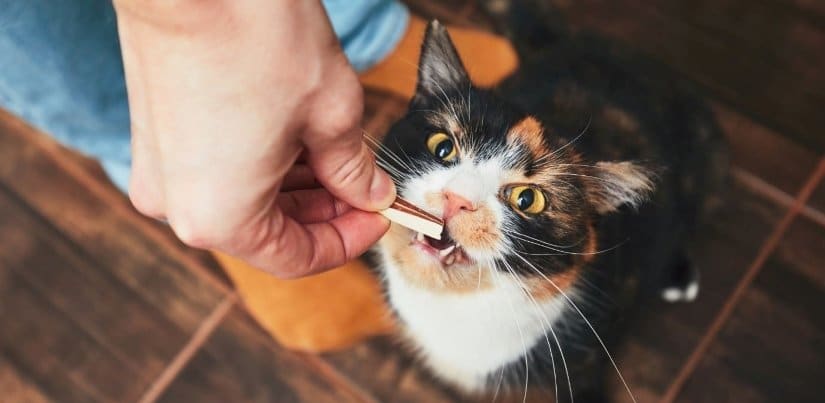
With so many types of high-quality cats treats available today, opt for the healthy cat treat options. Treats are used to reinforce positive training with the clicker. Cat parents use high- protein treats like cooked fish and chicken bits as rewards during cat training. Since all cats enjoy food, it is always easy to use during cat clicker training. Cat treats some in different flavors. Here’s what to look out for when purchasing cat treats.
- Fillers
- Artificial coloring
- Preservatives
- Fake flavors
- Sugar
- Low-quality ingredients
- By-product meals
- High-carbohydrate treats
High-quality cat treats are in turn part of a cat’s diet. Additionally, when feeding treats, pet parents need to realize that low-quality treats are simply unhealthy, and may cause weight gain in cats. Treats are not an indulgence, but should be combined with a healthy diet, and used for reward purposes.
Freeze–dried or dehydrated cat treats are good options because they can also be used as toppers in meals. Cat need to consume treats that are cat specific only, and treats that contain essential fatty acids like arachidonic acid. This helps with fat utilization, and how the body uses food for energy production. Jerky treats are also great, and can be made from duck, venison, beef, lamb, chicken or fish.
Cat parents need to inspect the ingredients list, and make sure that the ingredients are US sourced for safety. It is important to also look at how the treats are made, and to keep in mind that no-heat processes that don’t damage nutrients are healthier for cats to eat. The no-heat process also kills pathogens, resulting in healthy and safe ingredients.
Clicker Training Your Cat to Walk Safely on a Leash
Cats are one of man’s most popular companion animals today. Our furry feline friends have rich emotional lives that we need to respect and understand. Cat parents must earn a cat’s love, trust and respect throughout the positive training process.
As much as there are so many different cat breeds and colors, there are some individual feline traits that are the same in all cat breeds. That said, we need to take into consideration all the individual quirks that a cat may have when clicker training a cat to walk safely on a cat leash.
Leash training your cat will strengthen the bond that you have with your cat. Cats are built to exercise and move around, and plenty of external stimuli will provide them with natural sunlight, fresh air and an opportunity to make new feline friends.
Clicker Training Tips for Your Cat

Think about how your cat responds to you when you offer him treats. You’ll be using this response to help with training your cat to walk safely on a leash. By having a variety of delicious treats immediately available for your cat, you’ll be making positive training that much easier and faster.
By combining the clicker with treats as a reward, your cat will soon understand what is being asked of him. That said, you’ll have to keep in mind that some cat breeds may be more difficult to work with. Additionally, the sooner you get your kitten used to a lightweight cat collar and leash, the sooner you’ll be able to take him or her for those relaxing long walks. Here’s how cat clicker training works:
- You will first have to get your cat’s attention by calling his name. This is done by clapping your hands lightly and saying his name.
- As soon as your cat looks at you when you call his name, click and reward with a favorite treat. In the beginning, it’s best to use a very high-quality cat treat like grilled tuna bits or whitefish flakes.
- Next, call your cat again and try to get him to come to you. As soon as he moves, click the clicker and reward again. That said, you cat needs to be wearing his lightweight collar and leash. In the beginning stages, it’s not necessary to hold the leash or to apply any tension whatsoever on the leash.
- Each cat training session needs to take 3-5 minutes. This allows for your cat to focus on you, and learn new commands without getting bored or stressed out. It also allows for each cat training session to end on a good note where both you and your cat and happy with each other.
- When your cat has repeated this process a few times and is walking to you with the leash trailing behind him comfortably, you can then start holding the leash lightly and repeating the training steps all the while using the clicker and treats to reinforce the behavior required.
- Your cat should be walking comfortably on a leash without any resistance before you decide to take him outside on a walk.
- The first trip outside needs to be in your garden, or in a safe environment with few distractions.
- You will need to keep using the clicker and rewarding outside until your cat is 100% trained to walk on a leash with no resistance.
- The first few cat walks outdoors should be short and no longer than 5-10 minutes. Make sure that you’re not in an environment that is very dog friendly, so that your cat is not stressed out by people walking their dogs.
Why Cat Vaccinations Are Important?
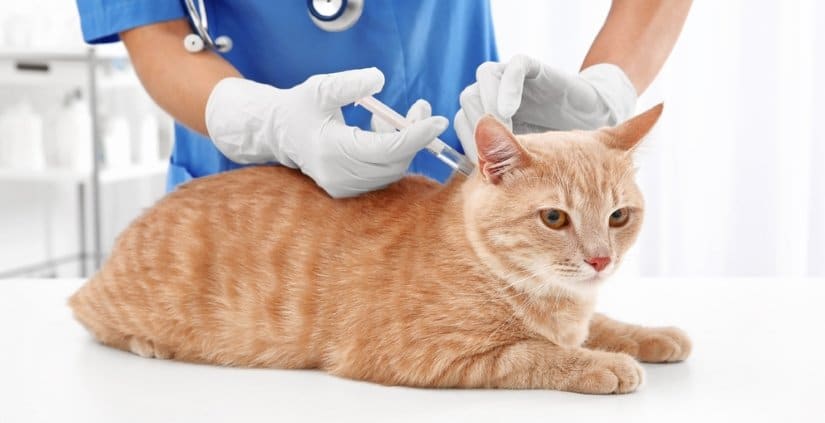
Your cat is going to need routine health care. This includes regular veterinary care for vaccinations, parasite control, dental cleanings and complete veterinary examinations.
Kittens will need to visit their veterinarians every 3 to 4 weeks until they reach 4 months of age. Older cats will need to continue visiting their vets twice or more yearly due to illness being more common in older cats. Geriatric cats will need to be on a special diet, but will also need yearly vaccinations to maintain a healthy lifestyle and longevity.
With core vaccinations for cats being an important part of preventative medicine, it’s necessary for pet parents to follow-up on all scheduled vaccination dates with their cats. Vaccinations stimulate the immune system against infection before cats get exposed to a disease. That said, there are several important vaccinations that your cat will need throughout his lifetime which will protect him or her against very serious infectious diseases.
Booster vaccinations are given every year to maintain ongoing protection. Consult with your veterinarian for the best advice when it comes to vaccination schedules for cats.
Identification Tags, Microchips and Collars for Cats
There’s no such thing as too much ID for cats! Ideally you cat should be microchipped, wear a collar with an ID tag, and get your cat tattooed for identification purposes in case he or she gets lost. This makes it much easier to keep your cat protected if they run out of the front door unexpectedly.
Both the microchip and ID tag should be used together in case the collar breaks away, gets attached to something, or is taken off by someone. Your veterinarian will insert the painless microchip between your cat’s shoulders.
If your cat goes missing, whoever finds your cat can bring him to an animal shelter or veterinarian, where he or she will get scanned. The chip manufacturer is notified, and all your cat’s information is then retrieved from the chip. You will then be notified that someone has your cat, and make the necessary arrangements to bring your cat safely back home.
Cats Flea Collar
Outdoor cats may get external parasites like fleas and ticks. They are also more prone to intestinal parasites, and being exposed to dangerous chemicals like antifreeze. By taking your cats for long outdoor walks, you’ll be exposing him to parasites, and will need to use parasite control against both internal and external parasites. That’s not to say that indoor cats should not be given preventative parasite meds. Common parasites in cats are:
- Roundworms
- Hookworms
- Heartworms
- Intestinal Protozoa like toxoplasmosis and coccidea
- Lungworms
- Fleas
- Ticks
- Mites
- Tapeworms
- Cuterebra (fly larvae contact near rodents)
Monthly preventative meds can be purchased from your veterinarian, and are necessary to prevent and treat fleas, ticks, mites, and heartworms. Your veterinarian will run a blood test to check for heartworm. There is no treatment for heartworm, so it’s really important to start using preventative monthly meds on your kittens early on.
Mites
Mites may result in the following:
- Itching
- Mange
Mange mites are not only annoying, but may result in skin infections and bald patches. Consult with your veterinarian for advice.
Toxoplasmosis
This is easily transferable from cat to human, yet only causes a mild digestive upset in cats. Pregnant women should not clean out their litterboxes, but should ask someone else to do so. Toxoplasmosis is transmitted via eggs through ingested organisms, and causes organ damage in humans.
Lightweight Cat Collars, Harnesses and Leashes
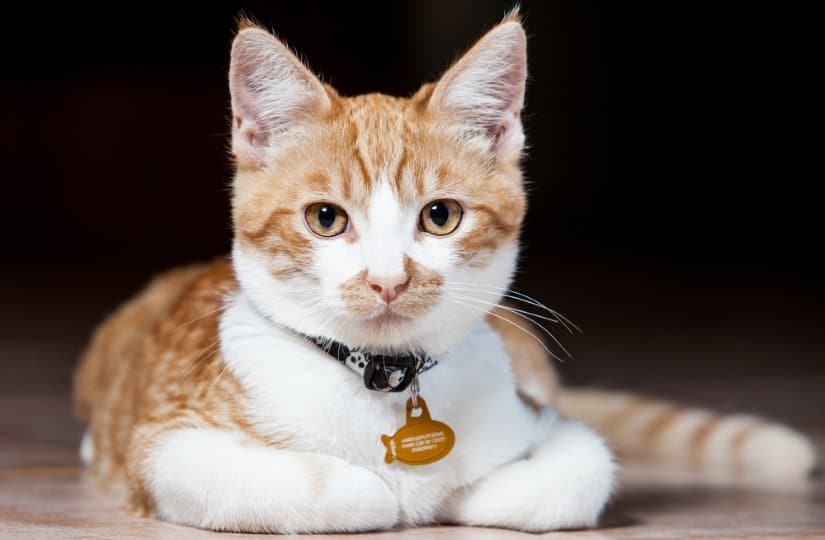
You may be wondering why the right type of cat leash is important to keep your cats safe on a walk? It is much safer to attach your cat leash to a cat harness, so that your cat does not slip out of his or her collar while going on a walk. Cat harnesses need to fit comfortably, and to have a secure fit.
Lightweight cat harnesses are necessary to keep your cat safe on walks. Since cats are carnivores and predators, they are natural hunters. By getting your cat used to wearing his lightweight cat harness, you can train him to get used to leash walking. That said, you’ll keep all the wildlife safe since he’ll be on a leash. Here are what to look out for when purchasing a cat harness:
- Durable
- Comfortable
- Adjustable
- Easy-to secure
- Allows for freedom of movement
- No friction
- Multicolor choices
- Trendy
- Buckle, hoop, and loop closures durable
Mental Stimulation for Your Cat
Most of us need to go to work each day, leaving pets behind at home that most probably get bored. By taking steps to ensure that your cat has plenty of entertainment, it’s best to allocate quality time every day for kitty. All cats benefit from one-on- one time with their pet parents.
During this time, you will need to make contact with your kitty, and organize a mini playtime with some interactive cat toys. This can be loads of fun even with the simplest toys.
Before leaving home each morning, make sure that your cat has a window that he or she can look out of. Cats enjoy watching birds, trees, and people go by. That said, there are also plenty of cat DVD’s that you can play that feature birds, dogs, fish and mice.
Indoor cats live a longer and safer life, and are not exposed to the dangers of being outdoors. Just make sure that your cat is physically active to prevent boredom, feline depression, and obesity.
Organize for an interactive feeder that will make your cat work for his or her food, and keep him busy. Cat hammocks and cat scratchers ensure that your cats get to climb, jump, and are physically active. By combining long relaxed walks with your cat with plenty of indoor activity, you’ll be ensuring that your feline is occupied and active.
